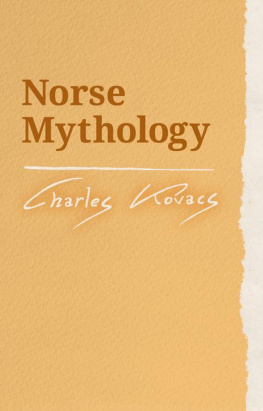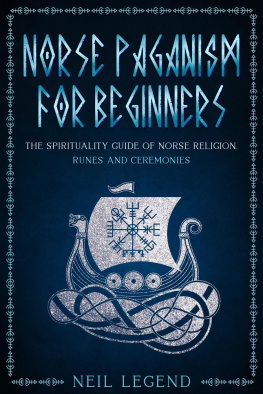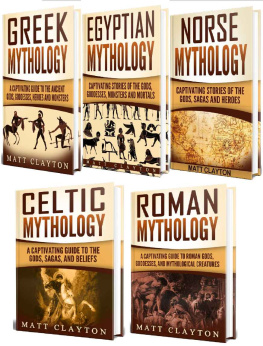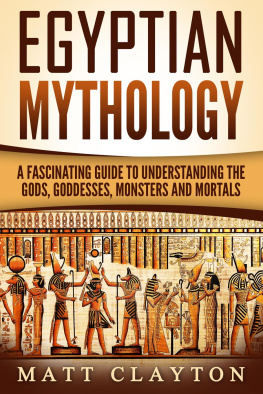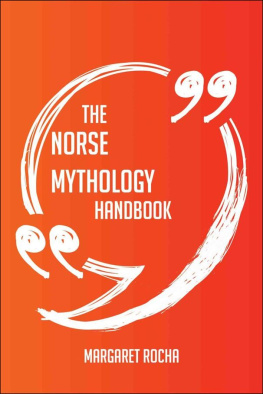I want to thank you and congratulate you for grabbing a copy of my book, Norse Mythology: The Heroes, Gods, Sagas, Beliefs, and Rituals of Nordic Mythology .
In this book, you will find a brief but comprehensive overview of the myths and religious beliefs underlying the gods, monsters, heroes, and heroines of Norse mythology.
You may already be familiar with names and personalities such as Odin, Thor, Loki, and the Valkyries and in this book you will learn about the many roles that they play within the various legends and sagas that have been passed down from generation to generation. You will learn about the impact that they have made on both the ancient Scandinavian cultures from where the stories arose, and on modern culture in northern Europe.
You will also learn how Norse mythology has become a leading source of storytelling ideas, and how the concepts and characters have found their way into works as diverse as Tolkiens The Lord of the Rings and Gaimans American Gods; the operas that make up Wagners acclaimed The Ring of the Nibelung ; the musical genres of heavy metal and, specifically, Viking metal; and many others.
Finally, I hope that reading about Norse mythology will help you gain a better understanding of the ancient cultures of Scandinavia: specifically, how these people saw the world and how they perceived themselves as they fit into that world.
Chapter 1
Norse Culture and the Importance of Mythology
From perhaps the very dawn of time, human beings have found themselves compelled to perform different actions in order to survive. We have hunted animals for their meat and for the rest of the resources that we could scavenge from their dead bodies. We have foraged for fruits and vegetables and the many other products from trees, shrubs, and grass. We have fought off predators, whether they were of our own species or of others. And, we have gathered in groups partly because of the idea of safety in numbers and partly because larger numbers meant a greater chance of survival for a longer time.
So what happened within those groups when the sun had set, taking away the light that was needed for successful hunting and foraging? What happened when the cold seasons came, or the storms? What did we do? We have made tools. We have looked after our young ones and our elders. We sang and danced. And we have told stories.
It might look useless on the surface, but think about it: if we didnt know how to tell tales, if we didnt naturally turn to making them up in order to better understand the world, then we wouldnt be able to pass on our skills and our knowledge to succeeding generations. These stories could capture the interest of the group; they could impart important skills and necessary warnings, and could even explain how the world works. Stories had their uses sure, many of them were little more than amusing little yarns, told just to pass the time. But some of them were epic world-spanning narratives that were used to transmit the lessons of history and the ideals that a member of the group should aspire to.
This would have been especially true during the winters in northern Europe. These elaborate accounts would have provided not just a means of passing the time, but also needed diversions for the family and for the community. The stories told in the night would serve many functions. For children, stories taught them about their history and culture, and could teach them the skills that they would need to learn in order to contribute to the community including the very necessary skill of learning their letters. For adults, the stories affirmed their shared struggles and shared heritage. Everyone would benefit from telling and retelling these same stories, and not just to forget the long dark hours before the short period of daylight could begin again.
For many people, the word mythology refers to a specific group of stories: stories of gods and monsters and heroes and war. Why are those stories referred to as myths? Because the gods and monsters and heroes and wars act out history. They explain the world as the storytellers understand it and they pass on customs and beliefs.
Most people think of the Greco-Roman gods and their follies when they hear the word mythology because those stories have been spread through various methods: travel, conquest, and especially in the modern day the sharing of Western culture through mass media.
It might be possible to say that for a long time Norse mythology was somewhat overlooked, lurking under the radar of popular culture, thanks to Christianity and its unhappy tendency to lump all other religious belief systems under the derogatory term pagan. But the names have persisted and in the case of the days of the week, we use them over and over again, thoughtlessly, just as a means of marking the passage of time. Nowadays, it is pretty easy to have a conversation about the modern versions of characters such as Thor and Loki and, again, we have Western culture and the mass media to thank for that.
But if we take away the comic books, the musical references, and the modern reinterpretations, who are these characters, really? Who are they in their original contexts and in their original stories?
Lets take Thor as an example. Featured in many a tale for his godly martial prowess, he has come down through the ages and sagas as the one member of the pantheon who seemed to feel true compassion for mortal men and women. Though his father, Odin, bestowed great gifts on humanity, the older god was greatly preoccupied by the looming specter of defeat and the end of all worlds, leaving Thor to take special care of the mortal world. How did he do it? By fighting and defeating the marauding giants who were a perpetual threat not just to humans, but to the gods themselves as well.
And, that is actually Norse mythology in a nutshell. When the stories were new, northern Europe was a world of long days at work, fierce battles between rival families, missionaries who were dogged and ruthless in spreading their religion, and the dark winter nights. The Vikings believed that they lived in a somber world, even though they could bring back great riches from their sea raids and even though they could earn great amounts of gold from trading their goods.
As a form of respecting those beliefs, the storytellers did their attentive audiences the favor of never sugar-coating the stories. They could throw in a few riddles or create the hope that someone might stumble over some storied treasure, or embellish the action in battles that were already exciting in and of themselves but they never shied away from the idea that life outside the four walls of home or the makeshift enclosures surrounding their villages would always be full of dangers both known and unknown.
We must give some credit to the countless men and women who told and retold the legends that soon became codified into the corpus of Norse mythology, however, because they still tried their best to include some kind of hope, some thread of redemption, into the stories of fallen heroes and gods who could be killed. Here, at the very beginning of this book, are the lines that talk about the morning after the end of the world, where new men and new gods wake up to a new heaven and a new earth:
In wondrous beauty once again
The dwellings roofed with gold
The fields unsowed bear ripened fruit
In happiness forevermore.
These lines are taken from Edith Hamiltons brief look into Norse mythology, in her classic work Mythology: Timeless Tales of Gods and Heroes .


